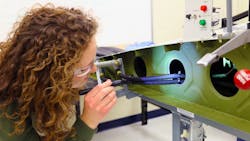FAA Awards Northeast State Community College Air Agency Certificate for Aviation Tech Program
Northeast State Community College received news that the Federal Aviation Administration (FAA) issued the Air Agency certificate and Airframe rating for the College’s Aviation Technology program.
The FAA performed an in-depth inspection and evaluation of Northeast State’s Aviation program in December and awarded the Air Agency Certificate to the College on Jan. 15. The assessment was performed to ensure the curriculum, training equipment, instructor qualifications, procedures, and documentation met federal aviation regulations.
“With the airframe rating, we are the only community college in the state of Tennessee that offers an associate degree with an FAA certification,” said Richard Blevins, assistant professor and director of the College’s Aviation Technology department. “The FAA Part 147 Airframe rating is a tremendous milestone for the Aviation Technology program and the region.”
The air agency designation and airframe rating grants the Aviation Technology program the FAA’s Part 147 airframe certification for aviation teaching schools. Next on the agenda is the accompanying powerplant rating for aviation instruction programs. The powerplant rating addresses the engine and mechanical operations of an aircraft.
“The airframe category covers every part of the aircraft except for the engine itself,” said Blevins. “Also, we have a lot of subcomponents for the every sub-assembly of an aircraft and training that replicates every part of an aircraft.”
The airframe and powerplant license is generally known as an “A&P” because most aviation mechanic candidates opt to complete both. To perform maintenance, repairs, or tests on an aircraft, these certifications must be earned at an FAA-certified institution, on-the-job, or through military experience. A&P licensed mechanics to perform maintenance, repairs, and alteration tasks on aircraft, including the engines, airframes, landing gear, avionics, fire suppression, brakes, and air-conditioning system.
Northeast State offers an associate of applied science degree (A.A.S.) in Aviation Technology and a technical certificate in Aviation Maintenance Technology. The two-year degree program requires students to complete 63 credit hours of core curriculum courses and aviation-specific courses. A student earning an associate of applied science degree in Aviation Technology qualifies to earn an aviation mechanic’s certificate/license.
“We are the only college in the United States that offers this program free to Tennessee residents,” said Blevins. “Through Tennessee Promise, qualifying students will be able to get an A&P mechanic’s license at no cost.”
Students entering the A.A.S. degree program learn skills associated with the repair and installation of aviation electronics, aircraft structures, and aircraft mechanical systems. Students also develop core skills in fuselage and sheet metal repair, electrical systems, hydraulics, and aircraft repair.
The program presently operates classroom and laboratory space in the College’s campus in Gray. The College expects to relocate the program’s entire instructional operation to a refurbished 13,000-square-foot hangar on the Tri-Cities Airport property later this year. The new teaching site opens the door to achieve the powerplant rating. Per FAA standards for aviation technology institutions, the powerplant rating requires the new hangar’s space and teaching capacity.
The hangar’s renovation is expected to begin in February. Blevins said the targeted completion date for the renovation is July 31. He anticipated the College could acquire the powerplant certification within 60 days after moving into the new hangar this summer.
“We are going to coordinate with the FAA, and they will be working with us during the renovation,” he said. “We are working to ensure it is exactly what we need as a college and that it meets all FAA requirements.”
The college moved forward to acquire teaching tools for the powerplant curriculum. The air agency certification required a facility, teaching equipment, and a variety of instruction manuals written for each process in the curriculum. A slew of laboratory equipment ready to be delivered includes a turboprop and reciprocating engine test cells, tear-down engines, and remove and replace turbines.
When up and running, the aviation technology department expects to move a cohort of 24 students through every training cycle to the A.A.S. degree. Blevins said the program had a waiting list for students seeking to apply.
The remodeled hangar design features two classrooms to accommodate 30 students. The laboratory space includes work stations for the turbine jet engines. Other laboratory testing tools include a PT6A test engine – commonly used in helicopters and fixed-wing aircraft – and a Lycoming 0-320 gasoline reciprocating engine. A team of up to six students work together taking those various engines apart and rebuilding them.
The long-term goal develops the hangar into a regional aviation technology education center. Blevins said the program moved forward with unwavering commitment of support and resources from Northeast State President Bethany Bullock; Nikki Morrison, Northeast State’s director of Grant Development; and Gene Cossey, executive director at Tri-Cities Airport.
“We are going have a huge community outreach program,” Blevins added. “We plan to hold events for STEM teachers, girl scouts, boy scouts, civil air patrol cadets, and K-12 students to inspire and encourage aerospace and aviation.”
Created through a partnership with the Bell aeronautics company, the Aviation Technology program was developed to train aeronautic mechanics for the regional workforce. The College’s aviation program started as a certificate program in 2015. The program added an associate of applied science degree option two years later.
“The A&P certificate is recognized worldwide,” said Blevins. “This is going to open the door for aviation companies around the United States to know our students and Tri-Cities Airport.”
